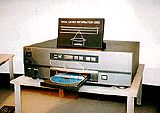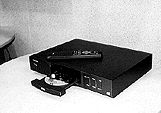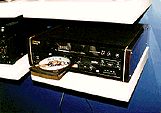Editorial - January,
1996
By John E. Johnson, Jr.
![]()
Well, we attended the 1996 Winter Consumer Electronic Show (WCES) in Las Vegas, held the first week in January. There were lots of new preamps, amps, speakers, and so on, but I know you are all interested in DVD, so let's talk about that first.
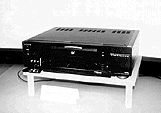 Sony had a wonderful demo set up, not only for
their DVD players, but also to show their Plasmatron flat panel
TV displays, and their new digital VCR (photo at left).
Sony had a wonderful demo set up, not only for
their DVD players, but also to show their Plasmatron flat panel
TV displays, and their new digital VCR (photo at left).
For the DVD demo, Sony used "Sleepless in Seattle" and "Speed". They demonstrated that the player could switch between wide screen and Pan and Scan, to suit viewers' preferences. We could not really see how well this feature worked because the demo was done on a wide screen (16:9) TV rather than a standard 4:3 set. We were only able to get about 10 feet away from the monitor, so any motion artifacts were not readily visible. However, the picture looked excellent from that distance . . . as good as anything (except HDTV) that I have ever seen. They also showed that, when using a DVD that is dual layered, switch from layer one to layer two is seamless, and it is indeed. I could not see any flicker at all. The outputs of the DVD player will include composite video (the single RCA video jack output we are used to having already) and S-Video (carries chroma and luminance on separate conductors), along with direct digital output (and/or six decoded analog jacks to be fed to five discrete audio inputs on a receiver, and subwoofer) for the audio. High end players should also have component video outputs, consisting of separate RGB (Red, Green, Blue) jacks and a sync (synchronization) jack (usable on good front projection TVs and possibly on computer monitors with these connectors). DVD is capable of delivering progressive line scanning images at 625 scanning lines (thus, no line doubler would be necessary). Our typical home NTSC TVs will convert (degrade) this image to an interlaced one at 525 lines. PAL/SECAM will use 625. TVs (in a reasonable price range) capable of displaying progressive line scanning apparently are in the works. They also demonstrated the AC-3 sound that accompanies the video from the DVD, but it was so loud ("Speed"), I could not really evaluate it. But it is AC-3, and probably the same quality as that from laserdisc.
Click HERE if your browser does not support tables.
DVD has the following specifications, compared with standard CD:
| CD | DVD | |
|---|---|---|
| Disc Diameter | 120 mm | 120 mm |
| Disc Thickness | 1.2 mm | 1.2 mm |
| Disc Structure | Single Substrate | Two bonded 0.6 mm substrates |
| Laser Wavelength | 780 nm | 650 and 635 nm |
| Numerical Aperture | 0.45 | 0.60 |
| Track Pitch | 1.6 um | 0.74 um |
| Shortest pit/land length | 0.83 um | 0.4 um |
| Reference Speed | 1.2 m/sec, CLV | 4.0 m/sec, CLV |
| Data Layers | 1 | 1 or 2 |
| Data Capacity | 680 megabytes | Single layer: 4.7 gigabytes |
| Double layer: 8.5 gigabytes |
DVD can have up to 8 languages, each with the AC-3 soundtrack,
and 32 sets of subtitles. Thus, if the original film is in
English, the movie can be dubbed in 7 other languages, each with
its own AC-3 sound track. However, for a single sided, single
layered disc, for 133 minutes of movie, there can be only 3 sets
of sound tracks (each with a different language) and 4 sets of
subtitles. The sound track will be either AC-3 OR standard two
channel PCM for Dolby Pro Logic. If the movie is longer than 133
minutes, or if more languages and subtitles are used, then a dual
layer disc is required. The formula to calculate the required
disc space is as follows: Picture complexity (average) 3.5
megabits/sec + number of languages X 0.384 megabits/sec + number
of subtitled languages X 0.01 megabits/sec = required bits for
one second X 60 sec/min = number of bits required for one minute
of audio/video X movie run in minutes = total number of bits
required for the movie, divided by 8 = number of bytes required
for the movie. Are you still with me so far? There will be a quiz
in 133 minutes.
Pioneer showed a unit that is capable of playing not only DVD, but laserdiscs as well. I imagine this will be quite popular. Their demo allowed me to get a few inches away from the monitor (again, a 16:9), and I was able to discern a motion artifact. It occurred at the edges of a young lady's hand when she moved it across the screen rapidly.
Overall, I was quite impressed with DVD. It appears to be very flexible, and has an excellent picture quality. They quoted about 500 lines of horizontal resolution (vertical lines on the monitor). It will play standard CDs as well as DVD. The Digital VCR will record AC-3 sound tracks, and there is a plan to release movies on digital video tape. We were told by Toshiba that their initial DVD players will be $599 and $699 (the more expensive model has RGB outputs). We should see them in the fall of this year. It will be nice to have Ben Hur all on one side (dual layer) of one disc. Dozens of movies on DVD are scheduled to be released at the same time as the players. A caveat here is that DVD at the WCES was a series of finely tuned professional demonstrations using prototypical players, and we don't know how that will translate to the actual product that we get to take home with us eight months from now. Time will tell if what we saw in Las Vegas is what we get later.
One thing that bothers me about all this is that HDTV and high density CDs (probably 96 kHz sampling, 20 - 24 bit word length) are only about two years away . . . how long have we been hearing that? (HDTV broadcasts in North America are scheduled for late 1997.) I wish the manufacturers would just wait and make DVD and digital VCRs (digital camcorders are already available to consumers) at HDTV capability (720 lines of horizontal resolution x 1280 lines - scanning lines - of vertical resolution) and DVD able to play high density audio CDs to begin with. I heard some discussion about adaptability, but it is unclear how this occurs, i.e., you buy a new DVD player, digital VCR, and digital camcorder that have HDTV performance chips in them, or replace some chips in existing units. From all that I can ascertain from the manufacturers, DVD players will not be forward compatible since the standards for the new technology have not been engraved in stone. I guess they figure that it will be a considerable time before HDTV monitors and high density audio CD players are in a significant number of homes, so they are building the digital units to work on what we have now, namely NTSC and PAL/SECAM TVs, and standard CDs. A large number of companies are making the various products, and they want our consumer dollars now, not in years down the road. If you look at it from a practical standpoint, here is what might happen. DVD and digital VCRs are released in 1996. We buy them. HDTV broadcasts and HDTVs are available in late 1997, perhaps along with high density CD players. Consumers start buying them, but not at the pace of DVD. By the year 1999, HDTVs are in enough homes that HDTV broadcasts are expanded. The year 2000 comes, and we are ready to buy a new DVD player that will also handle HDTV and High Density Audio CDs, and maybe a new digital VCR too. Voila, HDTV DVD players, and HDTV VCRs hit the market. If we haven't bought an HDTV yet, we do it then, and the HDTV DVD, and the HDTV VCR, maybe not all at once, but perhaps over a period of a year or so. (If I am completely wrong about these predictions, I'll sneak back in here and modify the dates in the archived file.)
 Bob Carver with the new sub driver.
Bob Carver with the new sub driver.
Moving on to other, perhaps more mundane,
yet still interesting equipment shown at the WCES,  we found some cool new subwoofers by Sunfire and
Velodyne. The Sunfire uses a piston driven by an amplifier of
several thousand watts (yes you read that right). It is a
radically new design (do we expect anything else from Bob?), and
it thunders beyond belief. It moves as much air as four 15"
drivers. All in about a 12" cube, and selling for $999.
Available soon. (That's Bob on the left, holding the driver.) The Velodyne (shown on the right) is a modification of the F series,
plays a few dB louder, and uses a metal cone. The amplifier is
programmable so that if you have, say, a 35 Hz peak in your
listening room, you can attenuate the sub at that frequency.
Price should be about $200 more than the standard F series.
Available soon.
we found some cool new subwoofers by Sunfire and
Velodyne. The Sunfire uses a piston driven by an amplifier of
several thousand watts (yes you read that right). It is a
radically new design (do we expect anything else from Bob?), and
it thunders beyond belief. It moves as much air as four 15"
drivers. All in about a 12" cube, and selling for $999.
Available soon. (That's Bob on the left, holding the driver.) The Velodyne (shown on the right) is a modification of the F series,
plays a few dB louder, and uses a metal cone. The amplifier is
programmable so that if you have, say, a 35 Hz peak in your
listening room, you can attenuate the sub at that frequency.
Price should be about $200 more than the standard F series.
Available soon.
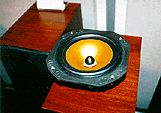 We met with Mo Iqbal and Ross Ginn, of Monitor Audio
speakers. They showed us a new driver design (shown on the left) that incorporates a
special curved cone. It will be used in some speaker models but
not others (not the Studio 20 SE or Studio 50, for example).
We met with Mo Iqbal and Ross Ginn, of Monitor Audio
speakers. They showed us a new driver design (shown on the left) that incorporates a
special curved cone. It will be used in some speaker models but
not others (not the Studio 20 SE or Studio 50, for example).
Numerous companies showed new AV
receivers/preamplifiers. Some will be AC-3 compatible with
processors coming later this year.
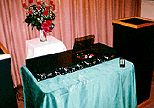 |
 |
| Thorens | Polyfusion Audio |

Bruce Edgar showed his latest modification of the Edgarhorn, at
$9,000 the pair. Horn speakers are very sensitive, and this
particular design was so sensitive (107 dB/w/m) that room filling
volume was heard at about 1 watt of power amp input per channel.
This makes them ideal for low wattage class A, single ended tube
amps.
 Several Electrostatic
speakers were shown. What turned out to be one of the most
impressive sound setups at the show consisted of Sound Lab A-1
full range electrostatics ($13,250/pair) powered by Fourier
Panthere Tube OTL (Output TransformerLess - no output
transformers) amplifiers ($9,950). Amrita Audio
showed a very tall (about 6 feet) set of oak veneer speakers at
$3,000/pair. They are backordered, needless to say. On the home
theater range, Mirage speakers just blew us away with their AC-3
demo using Mirage bipolar subs all the way around. This further
convinced me that multi-sub configurations will be popular with
AC-3 (and DTS).
Several Electrostatic
speakers were shown. What turned out to be one of the most
impressive sound setups at the show consisted of Sound Lab A-1
full range electrostatics ($13,250/pair) powered by Fourier
Panthere Tube OTL (Output TransformerLess - no output
transformers) amplifiers ($9,950). Amrita Audio
showed a very tall (about 6 feet) set of oak veneer speakers at
$3,000/pair. They are backordered, needless to say. On the home
theater range, Mirage speakers just blew us away with their AC-3
demo using Mirage bipolar subs all the way around. This further
convinced me that multi-sub configurations will be popular with
AC-3 (and DTS).
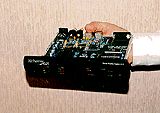 On the video side, Audio Alchemy showed a prototype
of an outboard comb filter that will sell for $599. It has chip
sockets for future capabilities regarding ghost reduction and
line doubling. And, as I mentioned above, the Sony Plasmatron flat
panel TV displays were shown. They have progressive line scan
(note comments about DVD progressive line scan capability above).
Awesome image quality.
On the video side, Audio Alchemy showed a prototype
of an outboard comb filter that will sell for $599. It has chip
sockets for future capabilities regarding ghost reduction and
line doubling. And, as I mentioned above, the Sony Plasmatron flat
panel TV displays were shown. They have progressive line scan
(note comments about DVD progressive line scan capability above).
Awesome image quality.
That's it for WCES, 1996. Sorry, we don't have bandwidth for more photos, but I wanted to focus on what I knew you were waiting to hear about (DVD). More extensive show reports for you to look at will be published in the paper trade magazines later on, I'm sure.
Secrets of Home Theater and High Fidelity on the web is doing great . . . growing like crazy. We are the first to use animation to illustrate technology in equipment reviews, and the first to use sound bites for this purpose as well. I hope these features work on your web browser. If you have problems, let us know.
The home page is new, and will get even newer soon. There are more icons to select from, including direct to movie reviews and music reviews icons. There is a search engine now, and you can use it to find particular equipment reviews, all reviews on a certain manufacturer, even authors.
We appreciate all the kind comments you have been making on the listserver (hifisecrets).
The Editor's Choice Hi-Fi Kit for Volume 3, Number 1, 1996 is as follows (in the last issue, it was a home theater setup; in this issue it is a stereo audio system):
| Input Source: | McCormack SST-1 CD Transport and DAC-1 |
| Interconnects to preamp: | Nordost Red Dawn |
| Preamp: | Audio Electronic Supply Pure Class A, Single Ended Tube Triode |
| Interconnects to Power Amps: | Nordost Red Dawn |
| Power Amps: | White Audio B-80 MOSFET Push Pull Monoblocks, 80 watts/ch |
| Speaker Cables: | AudioQuest Argent (softer high end) or Nordost Red Dawn (crisp high end) |
| Speakers: | Monitor Audio Studio 20 SE (received our 5 star award) |
This kit represents many, many hours of listening and fine
tuning, and we feel it is a combination that produces
breathtaking sonic performance where you can truly "listen
to the music" and stop worrying about the equipment that is
reproducing it.
John E. Johnson Jr.
![]()
© Copyright 1995, 1996, 1997
Secrets of Home Theater & High Fidelity
Return to Table of Contents for this Issue.

